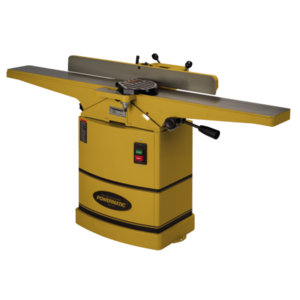Difference between revisions of "Jointer"
| Line 46: | Line 46: | ||
==Training== | ==Training== | ||
| − | ==== | + | ====Operation==== |
Insert Text | Insert Text | ||
Revision as of 18:06, 24 October 2019
Make: Powermatic
Model: 54HH
Ace: Needed (Makerhub@georgefox.edu).
Location: Wood Shop
Description
The Powermatic jointer contains a 1HP motor and 6" capacity that will handle the most demanding work. The helical cutterhead provides quieter operation and finer finishing than conventional systems. The 4" dust port connects easily to any dust collector. Used to remove material from wood, as well as squaring to create straight pieces.
Here is an example of this piece of equipment being used.
Documentation
Terminology
- Cutter Head - Drum of carbide inserts that perform the cutting.
- Fence - Metal back-stop that is used to guide and control the angle of material being cut.
Training
Operation
Insert Text
Demonstration
Demonstrate you can safely setup the jointer. You will need to clean up one edge and one face of a board. Remember to never adjust the out feed table as it has been precisely set to the height of the cutter head. Adjusting the in-feed table will change the amount of material removed per pass. Do not set the in-feed table to remove more than 1/16" per pass. Your fingers should never go any lower than the height of the cutter guard. Verify the fence is locked and set at the angle needed before making a pass.
General Procedure
Edge Cleanup
1. Ensure that the material you are cutting is free from nails or foreign objects. Foreign material will damage the cutters and create flying hazards.
2. Make sure the board is at least 10" long and 1" wide to prevent the board from tilting while cutting.
3. Check the cut gauge on the front table. Make sure you know how much material is being removed. Never adjust the rear table.
4. Make sure the fence is tight and set at the correct angle
5. Check that the dust collector is connected.
6. Make sure the machine table is clear and press the power on switch for the jointer and dust collector.
7. Position your hands safely on the material and use a push stick if needed. A push stick is needed if your material is less than 2" thick. This will keep your fingers away from the cutter head.
8. Slowly feed the material through on the table to get a smooth finish.
9. After making a pass inspect the material to see if another pass is needed. Multiple passes are normally required to get the desired results.
10. Power off the machine and dust collector.
11. Reset the space.
Facing Material (planing)
1. Ensure that the material you are cutting is free from nails or foreign objects. Foreign material will damage the cutters and create flying hazards.
2. Make sure the board is at least 10" long and 1" wide to prevent the board from tilting while cutting.
3. Check the cut gauge. When facing you normally want to take off a small amount of material per pass due to the large surface area.
4. Make sure the fence is tight and set at the correct angle
5. Check that the dust collector is connected.
6. Make sure the machine table is clear and press the power on switch for the jointer and dust collector.
7. Position your hands safely on the material. A push stick is needed if your material is less than 2" thick. This will keep your fingers away from the cutter head.
8. Slowly feed the material through on the table to get a smooth finish.
9. After making a pass inspect the material to see if another pass is needed. Multiple passes are normally required to get the desired results.
10. Power off the machine and dust collector.
11. Reset the space.
Safety
There are several hazards you need to be aware of when using a jointer.
- The cutters are very sharp and spin very fast. Keep your fingers away from the cutter head even when its not spinning. Use a push pad/stick to keep your fingers a safe distance from the cutters.
- Never let your thumb or fingers hang down near the table when pushing a board through the machine.
- Hold onto material firmly and keep it against the table and fence to help prevent material kicking back. If material catches on the blade the material can shoot back at you and this is called a kickback.
- Use a hold down or push block when surfacing stock less than 12" long, or 3 inches wide, or 3 inches thick.
- Never feed material backwards.
- Never try to cut across grain as this could cause a kickback.
- Don't exceed 1/16" cut per pass.
This is a video showing how to safely use the jointer:
Certification
Troubleshooting
If the finish looks rough you may be feeding the material too fast. Try slowing down the speed you are feeding the material through.
Maintenance
General maintenance
Carbide cutters need rotating when they start to dull. This is a job for the technician.
Specific Maintenance Tasks
| Maintenance Procedure | Frequency | Done By |
|---|---|---|
| Sample | Sample | Sample |
